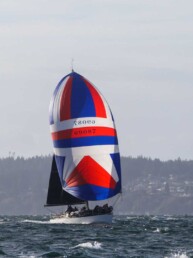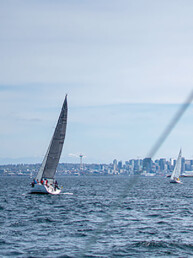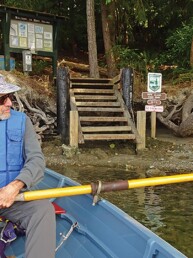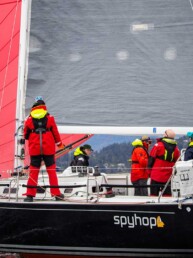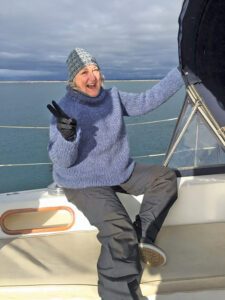
The forecast called for pleasant winds of 10-20 knots, a perfect day to do a trial run on a small boat we planned to eventually use for the Race to Alaska. My husband, Scott, and I decided to sail our Santana 23D 35 miles from our homeport of Port Angeles across the Strait of Juan de Fuca to Friday Harbor in the San Juan Islands. Any PNW boater knows that the strait is a stretch of big water that shares space with cargo ship lanes, large fishing vessels, whale watching boats, ferries, and other recreational vessels. Though these waters can certainly be placid, it’s also known to see rough conditions with heavy winds, rapidly developing storms, sloppy seas from varied tidal currents, and tall swells coming in from the Pacific Ocean. Even with high quality, modern forecasts, these conditions can change frequently and be quite unpredictable. On the day we chose for our crossing to the islands, the skies were clear and the winds seemed fair and in line with the predictions.
Reaching north under mainsail and jib, doing 7.5 knots in a prevailing westerly, we were on a beautiful port tack with winds filling the sails and excitement in our hearts. The once-distant archipelago came into view, and we could see the sea changing color and were preparing for a shift in the tide and perhaps some rougher chop, but we were ready and unconcerned. These are familiar waters for us. They are our sailing backyard and we have made this passage many times.
As we neared Cattle Pass between Lopez and San Juan islands, the sea state quickly changed and became confused. If you have never experienced this sensation, it’s as if you are sitting inside a washing machine when it is in the agitation cycle. On a small boat, this causes a sloppy, unpredictable, and uncomfortable motion. Ordinarily, I can ride out this sea state and remain focused. However, this time I immediately became seasick. I stood in the companionway, staring at the landmass ahead, bucket in hand, repeating the phrase: “Stay aware, keep breathing, stay centered.”
My husband worked the helm, attempting to minimize the motion and my seasickness when, suddenly, the tiller fractured right in his hands! All control was lost. I was standing there, unhelpful, fighting the next urge to purge. The boat rounded up in the waves and flogged uneasily. Though the challenge he was facing was different from mine, he used the same mantra — stay aware, keep breathing, stay centered — as he acted calmly and quickly. With duct tape, quick-set epoxy, and zip ties, he was able to repair the tiller. Within a few minutes the waters calmed. My seasickness subsided and I turned to see him, holding the repaired tiller, a look of astonishment on his face. We handled what could have been a very dangerous situation with relative ease.
The rest of the voyage into Friday Harbor went smoothly, and we were happy to arrive at our destination unscathed. Over beers at the brewery, we debriefed about our passage. How had we been able to handle the crisis that arose while remaining calm without screaming and yelling at each other or being overwhelmed with panic? It came down to the preparation and practice we had been doing on land.
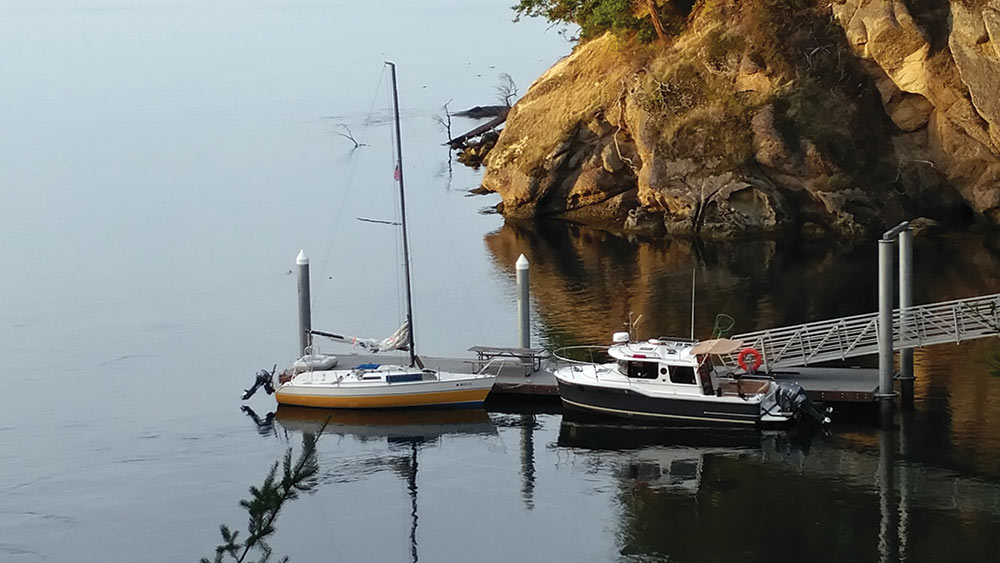
We sailors can spend thousands of dollars and hundreds of hours preparing our boats for cruising and long passages. We can spend almost as much money outfitting our bodies preparing for any weather, or untold hours trying to interpret GRIBs and forecasts that seek to predict it. But how do we prepare our minds and emotions for the stressors that can accompany even an easy day sail?
In addition to being a sailor, I am also a psychotherapist and Somatic Experiencing™ practitioner (an alternative therapy focused on treating trauma). What I know about humans, including sailors, is that we don’t handle stress and anxiety well. According to John Heiser, instructor at Medical Support Offshore, “the number one medical issue on board worldwide is mental health.” So then, why do we not gear our minds and emotions with the same level of care and intention as we do our boats and bodies?
As a specialist in trauma healing, I have spent my career teaching others how to regulate their emotional responses by paying attention to their body sensations, thoughts, and feelings. The mantra repeated by both my husband and I during our crisis at sea is one tool I designed. We have practiced it on land in many different situations. This mantra has helped many of my clients remain calm and alert during stressful times, and it can help you, too. I call it the ABCs: Awareness, Breath, Center.
A good sailor is unconsciously doing the ABCs all the time when it comes to physical safety on the boat. It is vital that we stay aware of our surroundings lest we trip over a line or get caught by the boom. Our regulated breathing is necessary to keep us awake and alert. Being physically centered in our bodies might keep us from falling overboard during a swell or gust of wind. Without being aware of it, our bodies are doing what it takes to be successful at sea. Taking this to the conscious level helps us to be emotionally successful as well, especially during stressful moments.
Awareness: Take a moment right now and look around you. Slowly, turn your head and look to the left, to the right, and in front of you. Turn your head and look over your left shoulder behind you and then over your right shoulder. Look down at your feet and up above your head. Take the time to really notice where you are. When stress begins, our nervous systems activate and our scope of focus narrows. Taking a few minutes to expand our focus back out helps to regulate our nervous system.
Breath: Notice where your breath is. Is it in your throat? Your chest? Your belly? Are you holding it? Is your diaphragm tight? Exhale. Inhale to the count of four, hold it for a count of seven and then exhale for a count of eight. Repeat this three times. Notice how your shoulders begin to relax, your chest feels less tight and your heart rate reduces. Notice if your breathing changes, if you are taking deeper slower breaths. This also helps to regulate our nervous system.
Center: Where are your feet? Wiggle your toes a bit, bring your attention all the way down to your feet. Notice them. If you are sitting, stand. If you are wearing shoes, are they tight, loose, comfortable? Can you feel the texture of your socks or the ground beneath your feet? Are your feet cold, warm, sweaty, or dry? Stand firmly on your feet. Notice how you balance your weight. Settle into your feet. Rock on the balls of your feet so you can feel your center of gravity. Bringing your attention to your feet helps you land fully in your body, down-regulating your nervous system and calming your body.
Notice how your body feels. Are you thinking more clearly? Are you feeling calmer? Become familiar with this sensation. Next time you feel stress and/or anxiety start to rise, pause, spend a few minutes doing your ABC’s, and then respond to the situation. The more you practice with this tool, the more quickly you can return to a state of safety, both mentally and emotionally whether on land or at sea.
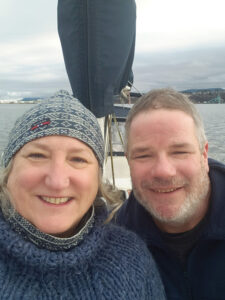
Prudent sailors must, of course, balance the need to act quickly in certain situations with the needs to act effectively. The thing to remember is that stress, panic, and hurry are seldom effective. Building your personal familiarity with the process of calming your mind and regaining clarity in stressful situations will help you respond adeptly and in a timely fashion at sea.
Scott and I have moved through two boats since the broken-tiller incident on the Santana 23D. We have had many opportunities to practice the ABCs, both individually and together.
While I hope you don’t ever experience an unexpected gear failure in a Strait of Juan de Fuca washing machine, I do hope that this article provides you with tools and assurance that you can navigate a difficult situation when one inevitably comes up. Thoughtful preparations for both our boats and our minds go a long way in helping us to enjoy sailing, our boat, and each other; and I believe it can do the same for you.
Jaelyn Wielbicki
Jaelyn Wielbicki, LMHC SEP, now lives in and sails out of Sequim, Washington. You can learn more about her work at www.jaelyn.love.

